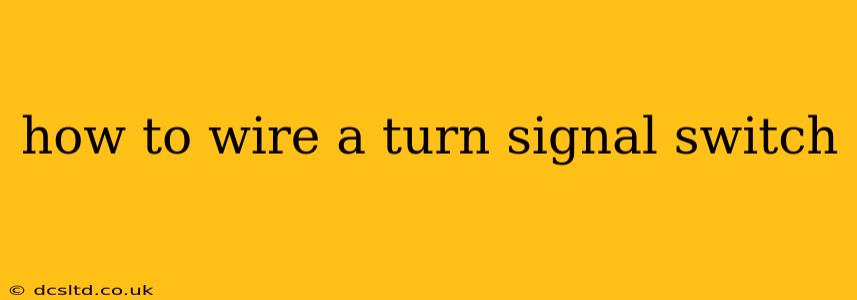Wiring a turn signal switch might seem daunting, but with a methodical approach and the right information, it's a manageable task. This guide will walk you through the process, covering various aspects and answering common questions. Remember, safety is paramount – always disconnect the battery's negative terminal before working on your vehicle's electrical system.
What Tools and Materials Will I Need?
Before you begin, gather these essential items:
- New turn signal switch: Ensure it's the correct replacement for your vehicle's make, model, and year.
- Wiring diagram: This is crucial for identifying each wire's function. You can usually find this in your vehicle's repair manual or online through reputable sources.
- Test light or multimeter: To verify power and ground connections.
- Screwdrivers (Phillips and flathead): For removing screws and connectors.
- Wire strippers/cutters: To prepare wires for connections.
- Electrical tape: To insulate connections securely.
- Optional: Crimping tool: For creating more secure wire connections.
How Do I Identify the Wires on My Turn Signal Switch?
This is where your wiring diagram becomes invaluable. It will show you the color codes and the function of each wire connected to the turn signal switch. Common wires include:
- Left turn signal: This wire activates the left-side turn signals.
- Right turn signal: This wire activates the right-side turn signals.
- Hazard lights: This wire activates both left and right turn signals simultaneously.
- Power: This wire provides power to the switch.
- Ground: This wire provides a return path for the electrical current.
Without a wiring diagram specific to your vehicle, attempting to connect the wires based on color alone is extremely risky and could lead to damage or malfunction. Locate your vehicle's wiring diagram before proceeding.
What are the Common Problems with Turn Signal Switches?
Several issues can cause a malfunctioning turn signal switch:
- Worn-out contacts: Over time, the internal contacts within the switch can wear down, leading to intermittent or complete failure of the turn signals.
- Broken wires: Wires can become frayed, broken, or disconnected due to age, vibration, or damage.
- Internal short circuits: A short circuit within the switch can cause erratic behavior or complete failure.
- Incorrect installation: Improper wiring during installation can lead to malfunctions.
Replacing the switch is often the most effective solution for these problems.
How Do I Test My Turn Signal Switch Before Replacing It?
Before assuming the switch is faulty, use a multimeter or test light to check the following:
- Power to the switch: Ensure power is reaching the switch's power input wire.
- Ground connection: Verify a good ground connection.
- Continuity in the switch: Test the continuity between the switch's input and output wires to ensure a complete electrical path. This requires some electrical knowledge and careful use of your multimeter.
If your testing reveals issues outside the switch, address those problems before replacing the switch.
How Can I Wire the New Turn Signal Switch?
- Disconnect the battery's negative terminal. This is crucial for safety.
- Remove the old turn signal switch. This process varies depending on your vehicle's make and model. Consult your repair manual for specific instructions.
- Compare the wiring of the old and new switches. Carefully examine the wire colors and positions on both switches to ensure accurate connection.
- Connect the wires to the new switch. Use the wiring diagram as your guide, matching the colors and functions precisely.
- Secure the new switch in place.
- Reconnect the battery's negative terminal.
- Test the turn signals, hazard lights, and other related functions. Ensure they work correctly.
What if My Turn Signals Still Don't Work After Installation?
If the turn signals are still malfunctioning after installation, double-check the following:
- Proper wire connections: Re-examine each wire connection for accuracy.
- Fuses: Check for blown fuses in the turn signal circuit.
- Bulbs: Make sure all bulbs are functioning correctly.
- Wiring diagram: Ensure you used the correct wiring diagram for your specific vehicle.
Remember, this guide provides general information. Always consult your vehicle's repair manual for specific instructions and wiring diagrams. If you're uncomfortable working with your vehicle's electrical system, it's best to seek professional help from a qualified mechanic.
